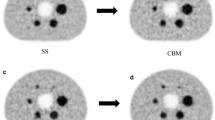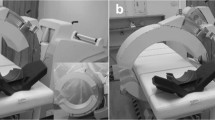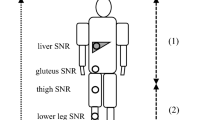Abstract
Purpose
We investigated whether images of stationary objects obtained by segmental acquisition with positron emission tomography using 2-deoxy-2-[18F]-fluoro-d-glucose (FDG-PET) are of a quality equivalent to those obtained by conventional continuous acquisition.
Materials and methods
Phantoms filled with FDG and mid-abdominal regions of 18 patients who underwent FDG-PET tests were imaged by both continuous and segmental acquisition methods. The total acquisition time was set to 3 min; in the segmental acquisition mode, imaging for 15 s was repeated 12 times. Segmental images (SIs) obtained by superimposition of the reconstructed images were compared quantitatively and visually with continuous images (CIs).
Results
In all the phantom and clinical studies, SIs were never worse than CIs. The variances of the background counts of SIs were 9.8% and 13.0% less those of CIs in phantom and clinical studies, respectively. Visual assessments showed that SIs provided better detection of hot areas and superior image quality when compared to CIs.
Conclusion
For stationary objects, the quality of images obtained by the segmental method is equivalent to that of images obtained conventionally by continuous acquisition. Moreover, under some conditions SIs provide better results than CIs.
Similar content being viewed by others
References
Endo K, Oriuchi N, Higuchi T, Iida Y, Hanaoka H, Miyakubo M, et al. PET and PET/CT using 18F-FDG in the diagnosis and management of cancer patients. Int J Clin Oncol 2006;11:286–296.
Bomanji JB, Costa DC, Ell PJ. Clinical role of positron emission tomography in oncology. Lancet Oncol 2001;2:157–164.
Beyer T, Townsend DW, Brun T, Kinahan PE, Charron M, Roddy R, et al. A Combined PET/CT scanner for clinical oncology. J Nucl Med 2000;41:1369–1379.
Inoue K, Sato T, Kitamura H, Ito M, Tsunoda Y, Hirayama A, et al. Improvement of the diagnostic accuracy of lymph node metastases of colorectal cancer in 18F-FDG-PET/CT by optimizing the iteration number for the image reconstruction. Ann Nucl Med 2008;22:465–473.
Vogel WV, Wensing BM, van Dalen JA, Krabbe PFM, van den Hoogen FJA, Oyen WJG. Optimised PET reconstruction of the head and neck area: improved diagnostic accuracy. Eur J Nucl Med Mol Imaging 2005;32:1276–1282.
Schöder H, Erid YE, Chao K, Gonen M, Larson SM, Yeung HWD. Clinical implications of different image reconstruction parameters for interpretation of whole-body PET studies in cancer patients. J Nucl Med 2004;45:559–566.
Pan T, Mawlawi O, Nehmeh SA, Erdi YE, Luo D, Liu HH, et al. Attenuation correction of PET images with respiration-averaged CT Images in PET/CT. J Nucl Med 2005;46:1481–1487.
Kawano T, Ohtake E, Inoue T. Deep-inspiration breath-hold PET/CT of lung cancer: maximum standardized uptake value analysis of 108 patients. J Nucl Med 2008;49:1223–1231.
Nehmeh SA, Erdi YE, Meirelles GSP, Squire O, Larson SM, Humm JL, et al. Deep-inspiration breath-hold PET/CT of the thorax. J Nucl Med 2007;48:22–26.
Meirelles GSP, Erdi TE, Nehmeh SA, Squire OD, Larson SM, Humm JL, et al. Deep-inspiration breath-hold PET/CT: clinical findings with a new technique for detection and characterization of thoracic lesions. J Nucl Med 2007;48:712–719.
Yamaguchi T, Ueda O, Hara H, Sakai H, Kida T, Suzuki K, et al. Usefulness of a breath-holding acquisition method in PET/CT for pulmonary lesions. Ann Nucl Med 2009;23:65–71.
Nagamachi S, Wakamatsu H, Kiyohara S, Fujita S, Futami S, Arita H, et al. Usefulness of a deep-inspiration breath-hold 18F-FDG PET/CT technique in diagnosing liver, bile duct, and pancreas tumors. Nucl Med Commun 2009;30:326–332.
Mawlawi O, Podoloff DA, Kohlmyer S, Williams JJ, Stearns CW, Culp RF, et al. Performance characteristics of a newly developed PET/CT scanner using NEMA standards in 2D and 3D modes. J Nucl Med 2004;45:1734–1742.
National Electrical Manufacturers Association. Performance measurements of positron emission tomographs. NEMA standards publication NU 2-2001. Rosslyn, VA: NEMA; 2001.
Defrise M, Kinahan PE, Townsend DW, Michel C, Sibomana M, Newport DF. Exact and approximate rebinning algorithms for 3-D PET data. IEEE Trans Med Imaging 1977;16:145–158.
Hudson HM, Larkin RS. Accelerated image reconstruction using ordered subsets of projection data. IEEE Trans Med Imaging 1994;13:601–609.
Burger C, Goerres G, Schoenes S, Buck A, Lonn AHR, von Schulthess GK. PET attenuation coefficients from CT images: experimental evaluation of the transformation of CT into PET 511-keV attenuation coefficients. Eur J Nucl Med 2002;29:922–927.
Ollinger JM. Model-based scatter correction for fully 3D PET. Phys Med Biol 1996;41:153–176.
Nagayoshi M, Murase K, Fujino K, Uenishi Y, Kawamata M, Nakamura Y, et al. Usefulness of noise adaptive non-linear gaussian filter in FDG-PET study. Ann Nucl Med 2005;19:469–477.
Strobel K, Rüdy M, Treyer V, Veit-Haibach P, Burger C, Hany TF. Objective and subjective comparison of standard 2-D and fully 3-D reconstructed data on a PET/CT system. Nucl Med Commun 2007;28:555–559.
Willinek WA, Born M, Simon B, Tschampa HJ, Krautmacher C, Gieseke J, et al. Time-of-flight MR angiography: comparison of 3.0-T imaging and 1.5-T imaging: initial experience. Radiology 2003;229:913–920.
R Development Core Team. R: A language and environment for statistical computing. Vienna, Austria: R Foundation for Statistical Computing; 2008.
Okano K. Cooled CCD camera technique for astrophotography. Tokyo: Seibundo-shinkosha; 2009 (in Japanese, authors’ translation).
Kagna O, Solomonov A, Keidar Z, Bar-Shalom R, Fruchter O, Yigla M, et al. The value of FDG-PET/CT in assessing single pulmonary nodules in patients at high risk of lung cancer. Eur J Nucl Med Mol Imaging 2009;36:997–1004.
Hellwing D, Graeter TP, Ukena D, Groeschel A, Sybrecht GW, Schaefers HJ, et al. 18F-FDG PET for mediastinal staging of lung cancer: which SUV threshold makes sense? J Nucl Med 2007;48:1761–1766.
Author information
Authors and Affiliations
Corresponding author
About this article
Cite this article
Tsuda, K., Aikawa, N., Suzuki, T. et al. Segmental acquisition method for stationary objects in 18F-fluorodeoxyglucose positron emission tomography tests. Jpn J Radiol 28, 591–601 (2010). https://doi.org/10.1007/s11604-010-0482-5
Received:
Accepted:
Published:
Issue Date:
DOI: https://doi.org/10.1007/s11604-010-0482-5




